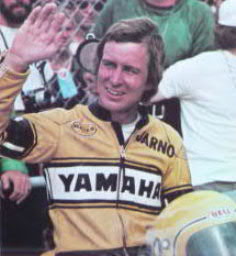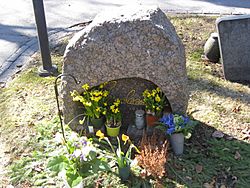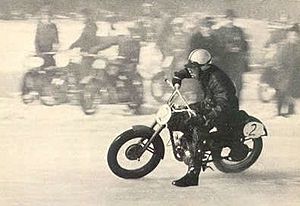Jarno Saarinen facts for kids
Quick facts for kids Jarno Saarinen |
|||||||||||||||||||||||||||||||||
|---|---|---|---|---|---|---|---|---|---|---|---|---|---|---|---|---|---|---|---|---|---|---|---|---|---|---|---|---|---|---|---|---|---|
 |
|||||||||||||||||||||||||||||||||
| Nationality | Finnish | ||||||||||||||||||||||||||||||||
| Born | 11 December 1945 Turku, Finland |
||||||||||||||||||||||||||||||||
| Died | 20 May 1973 (aged 27) Autodromo Nazionale Monza, Italy |
||||||||||||||||||||||||||||||||
|
|||||||||||||||||||||||||||||||||
Jarno Karl Keimo Saarinen (born December 11, 1945 – died May 20, 1973) was a super talented Finnish motorcycle racer. He competed in Grand Prix motorcycle racing, which is the highest level of motorcycle road racing.
In the early 1970s, many thought he was one of the best and most promising racers. Sadly, he died in a racing accident in Italy in 1973. His death made people demand much better safety rules for motorcycle races around the world. Jarno Saarinen is still the only person from Finland to have ever won a motorcycle road racing world championship. In 2009, Jarno was honored by being put into the MotoGP Hall of Fame.
Jarno's Racing Journey
Jarno Saarinen grew up in Turku, a city in southwest Finland. When he was 15, he started working as an apprentice and test rider for Tunturi-Puch. This factory in Turku assembled mopeds and motorcycles.
Jarno's first race was an ice race in 1961, where he finished second. He and his friend, Teuvo Länsivuori, enjoyed ice racing, grasstrack racing, and road racing.
Early Wins and Unique Style
In 1965, Jarno won the 250cc Finnish ice racing national championship. He was also good at motorcycle speedway racing. On August 4, 1968, he made his Grand Prix debut at Imatra. He rode a 125cc Puch and finished 11th in the Finnish motorcycle Grand Prix.
In 1969, he won both the 125cc and 250cc Finnish national championships. He even worked as his own mechanic!
Jarno was known for his special riding style. He would keep his chest very close to the motorcycle's fuel tank. When going around corners, he would lean his body to the inside of the turn and stick his knee out. This style influenced future world champion, Kenny Roberts. Jarno also angled his handlebars in a unique, almost vertical, way.
First Full Season and Big Steps
Jarno competed in his first full year in the 1970 250cc championship. He still worked as his own mechanic. He even convinced three bank managers to help pay for his racing, making them think they were funding his education!
He finished the season in fourth place overall. He missed the last three races to finish his engineering degree at the Turku Technical Institute.
In 1971, Giacomo Agostini was a huge champion. But Jarno showed his skill by winning his first 350cc Grand Prix race in Czechoslovakia. This happened after Agostini's bike had a problem. Jarno then finished second to Agostini in Finland. He also won the Nations Grand Prix in Italy.
Jarno raced in both the 250cc and 350cc classes in 1971. He finished third in the 250cc World Championship and second to Agostini in the 350cc class. He was very versatile, even finishing second in a 50cc race and then winning a 250cc race at the Spanish motorcycle Grand Prix.
Yamaha Factory Rider
Jarno's success caught the eye of Yamaha. They hired him to ride their 250cc and 350cc motorcycles for the 1972 season. Yamaha gave him a special 250cc Yamaha TD-3 bike.
Jarno proved Yamaha made a great choice. He won the 250cc World Championship after a close fight with Renzo Pasolini and Rod Gould. He also finished second in the 350cc World Championship. He challenged Agostini strongly, winning three races. This included a victory at the German motorcycle Grand Prix at the tough Nürburgring track. He even won both the 250cc and 350cc races at the Czechoslovakian Grand Prix.
Jarno's amazing performance made the dominant MV Agusta factory create a new 350cc motorcycle for Agostini. After the season, Jarno won the "Race of the Year" in Great Britain.
At the end of 1972, Jarno talked with the Benelli factory about riding their bikes. After a secret test, he beat Agostini in 350cc and 500cc races on Benelli bikes. Yamaha didn't want to lose him, so they signed Jarno to a special deal. He would race their new YZR500 for the 1973 season and defend his 250cc title. This deal meant he finally had mechanics, so he could focus only on racing. Yamaha was ready to challenge MV Agusta's long winning streak.
1973: A Strong Start
Jarno's 1973 season began incredibly well. He became the first European rider to win the famous Daytona 200 race in the United States. He rode a Yamaha TZ 350 against much bigger 750cc bikes. The Daytona 200 was one of the most important races in the world.
He then returned to Europe and won the prestigious Imola 200 race. Again, he beat riders on larger motorcycles with his TZ350.
Jarno took an early lead in the 1973 world championships. He won both the 250cc and 500cc races at the first event, the French motorcycle Grand Prix. He then had another double victory at the Austrian Grand Prix. He continued his winning streak by winning the 250cc German Grand Prix. However, he didn't finish the 500cc race there when his chain broke.
A Tragic Day
Jarno skipped the 1973 Isle of Man TT race, like many top racers, because they worried about safety. He arrived at the Nations Grand Prix leading both the 250cc and 500cc championships. The Monza Circuit in Italy was very fast. It had steel barriers lining the track, which left no room for mistakes for motorcycle racers. These barriers were put in for car racers after a bad accident in 1961. While they might have helped cars, they were very dangerous for motorcycles.
Jarno had complained about the guardrails at Monza, but nothing was done. Even though two new slow turns (chicanes) were added for cars the year before, they were not used for motorcycle races at Monza.
On the first lap of the 250cc race, a terrible accident happened. The second-placed rider, Renzo Pasolini, crashed into the guardrail and died instantly. Pasolini's motorcycle then bounced back onto the track and hit Jarno Saarinen in the head. The impact knocked off his helmet, and he suffered fatal head injuries. This caused a chain reaction, involving more than 14 riders. Several riders were seriously hurt. The race was stopped, and the next 500cc race was canceled.
Over the years, there was much debate about what caused the accident. Some thought it was due to oil on the track from an earlier race. One rider, John Dodds, even warned officials, but they threatened to remove him. However, the official investigation in September 1973 found that Pasolini's engine had seized (stopped suddenly), causing his crash.
Jarno's Lasting Impact
The tragedy at Monza shocked the motorcycle racing world. Two of the sport's best riders were lost. Major racing teams like Suzuki, MV Agusta, Harley-Davidson, and Yamaha came together. They demanded safer conditions at race tracks. Just 40 days later, three more riders died in the same turn during an Italian Juniors race.
One month after the Nations Grand Prix, race teams took a stand. They boycotted the Yugoslavian Grand Prix because the track was too dangerous. The Yamaha factory even stopped racing for the rest of the year to honor Jarno.

The deaths of Jarno Saarinen and Renzo Pasolini in 1973, along with Gilberto Parlotti in 1972, showed how badly safety needed to improve. Many Grand Prix races were still held on street circuits. These had dangers like telephone poles and railroad crossings. Even dedicated race tracks were dangerous for motorcycles because of the steel barriers.
Riders kept pushing for better safety throughout the 1970s. They even boycotted several races. The situation reached a turning point in 1979. The reigning 500cc world champion, Kenny Roberts, and a journalist tried to start a rival motorcycle championship. This forced the FIM (the sport's governing body) to take the riders' demands seriously.
New rules were passed, increasing prize money and making safety regulations stricter. Dangerous racing circuits were removed from the Grand Prix schedule. Tracks started replacing steel guardrails with safer run-off areas. This began a new era of professionalism and better safety in motorcycle racing. Today, major championships like MotoGP are held on closed, safer circuits. Monza now has slow turns to make it safer, but it is no longer on the main racing calendar. While crashes still happen, they are much less frequent and deadly than in the past.
The Ruissalo People's Park in Turku has a road named after Jarno Saarinen. The street in front of the Benelli motorcycle factory in Italy is also named Via Jarno Saarinen. The name Jarno became very popular in Italy in the 1970s. One famous person named Jarno is former Formula-1 driver Jarno Trulli.
In 2009, the F.I.M. put Jarno Saarinen into the MotoGP Hall of Fame. There is still an active Jarno Saarinen fan club in Italy. In 2014, they opened Jarno Saarinen Park in Petrignano, Italy. In 2016, a bronze statue of Jarno was put in the park. In 2017, a copy of the statue was also revealed in Turku, Finland.
Jarno Saarinen remains the only Finn to have won a motorcycle road racing world championship. He won 15 Grand Prix races and was a six-time Finnish national road racing champion.
Images for kids
-
Jarno Saarinen's grave in Turku, Finland.
See also
 In Spanish: Jarno Saarinen para niños
In Spanish: Jarno Saarinen para niños






